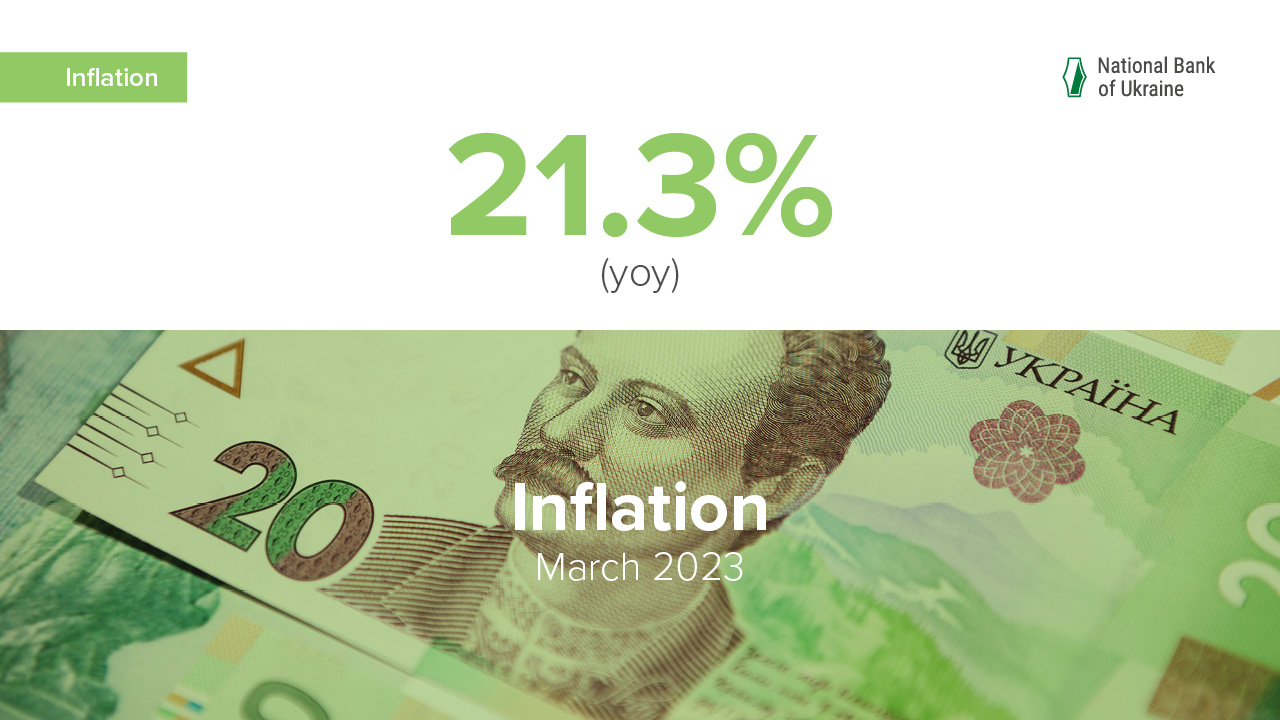In March 2023, consumer inflation in annual terms continued to slow to 21.3% yoy from 24.9% yoy in February. In monthly terms, prices grew by 1.5%. This is according to data published by the State Statistics Service of Ukraine.
The actual rates of price growth were below the trajectory of the NBU’s forecast published in the January 2023 Inflation Report. The plunge in inflation is associated with a significant supply of food and fuel, a better situation in the energy sector, improved inflation expectations, and favorable conditions in the cash segment of the FX market. At the same time, the slowdown in inflation is also largely due to last year's base effects.
Core inflation decreased to 19.8% yoy in March from 22.7% yoy in February
The rise in the prices of processed foods significantly decelerated, to 23.5% yoy. As with February, this was largely due to the better-than-expected energy situation. Specifically, prices for bread, flour products, confectionery products, nonalcoholic beverages, and canned food grew more slowly. Amid a sufficient domestic supply and a decrease in export prices, the growth in prices slowed for dairy products and sunflower oil. The improvement in exchange rate expectations, in particular amid a strengthening of the hryvnia in the cash segment, contributed to the decline in the pace of increase in the price of imported products.
The growth in prices for nonfood products also slowed significantly (18.8% yoy). On the one hand, such price developments had been expected because of the previous year's base effects. On the other hand, prices for personal care products, clothing and footwear, electronic devices, pharmaceutical products, furniture, household appliances, and cars grew more slowly thanks to the more upbeat exchange-rate and inflationary expectations.
The growth in services prices remained almost unchanged (15.4% yoy). Tourist services, the services provided by cafes, restaurants, and hotels, as well as rental services, grew in price more slowly. This may have been due to improved energy supply, weaker demand, and a high base effect created by the massive migration wave at the onset of the full-scale war. By contrast, the prices of healthcare, insurance, veterinary care, telecommunications, and beauty salon services grew faster, driven by increased costs and subdued supply amid a gradual recovery in demand. In addition, with demand being strong, price increases for services rendered by electricians and plumbers accelerated.
The growth in raw food prices slowed to 31.6% yoy
Milk prices grew more slowly due to sufficient supply against the backdrop of weak demand and a decrease in global prices. Prices for flour, cereals, and sugar rose at a lower clip, considering last year's harvests, which came out ample enough to meet domestic demand. The growth in meat prices decelerated due to the effects of lower feed prices and weak demand. A decrease in import prices and a favorable situation in the FX market led to a slowdown in price increases for citrus fruits and bananas.
At the same time, prices for greenhouse vegetables and carrots increased at a quicker pace, while the rate of decline in cabbage prices edged lower. This was primarily due to the fizzling out of the temporary effect of warm weather this past winter.
The increase in administered prices slowed to 13.5% yoy
Driven by sufficient import supply and the strengthening of the hryvnia in the cash market, the prices of tobacco products and alcoholic beverages rose more slowly. For the latter, the low-key price growth was also attributable to weaker demand. The growth in prices for transportation services slowed as well thanks to the stabilization of fuel prices. The moratorium on raising utility prices for households continued to restrain the increase in administered prices.
Growth rates of fuel prices decreased markedly, to 27.9% yoy
This is explained away by the availability of significant inventories and a retreat of global oil prices.
For the third straight month, inflation has been losing speed faster than the NBU had forecast, restrained by the excess of food supply over demand, improved conditions in the energy sector, and the central bank's consistent monetary policy aimed at maintaining exchange rate stability and making hryvnia savings more attractive. The improvement in inflationary and exchange rate expectations has helped ease underlying inflationary pressures. At the same time, risks to inflation developments persist primarily due to high uncertainty associated with the war.
All of these factors will inform the NBU's monetary policy decisions and the updated macroeconomic forecast, which is to be unveiled on 27 April 2023 during the NBU Board's press briefing on monetary policy. The NBU will publish a more detailed macroeconomic forecast on 4 May 2023 in its conventional Inflation Report.







